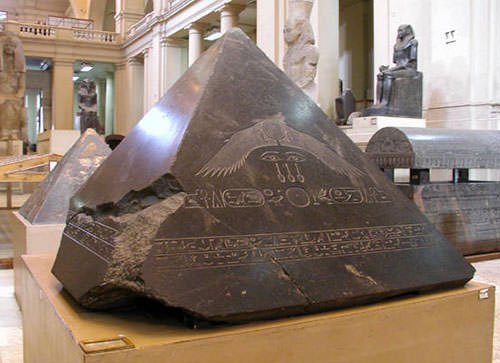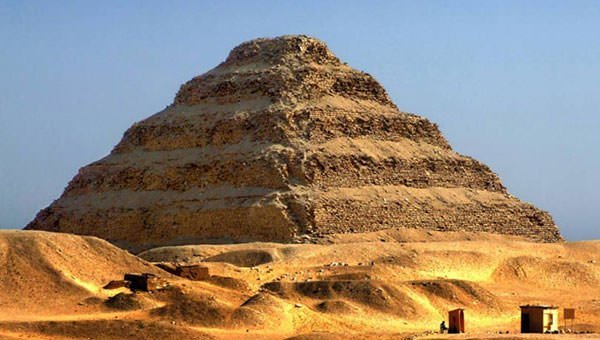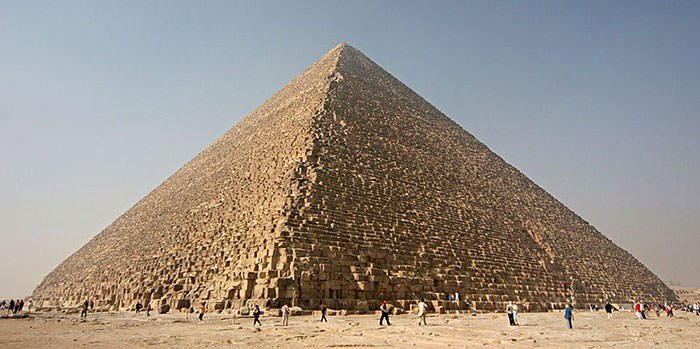Although pyramids have been built by civilizations in many parts of the world including China and Mesoamerica, the pyramids built in Egypt are the most famous. The first Egyptian pyramid was the Pyramid of Djoser, which was designed for the burial of Djoser, a 3rd dynasty pharaoh who ruled around the middle of 27th century BC. Initially the Egyptians built step pyramids and their first successful attempt to construct a “true”, or smooth-sided, pyramid was accomplished with the Red Pyramid at Dahshur. Egyptian pyramid building reached its pinnacle during the reign of Khufu with the construction of the Great Pyramid of Giza around 2560 BC. The last known Egyptian pyramid is the Pyramid of Ahmose, built in the first half of 16th century BC. Due to the preciseness and magnificence of Egyptian pyramids, especially the three main pyramids at Giza, there are many theories regarding their purpose and construction methods but none has been established with certainty. Here are 10 interesting facts about the Ancient Egyptian pyramids.
#1 EGYPTIAN PYRAMIDS WERE BUILT TO SERVE AS ROYAL TOMBS OF PHARAOHS
Despite the established view that pyramids were royal tombs, till date never once has a mummy of a pharaoh been found within a pyramid. This had led some to question the purpose of a pyramid. However, there is substantial evidence that suggests that pyramids were built for a mortuary function. It includes presence of sarcophagi or stone coffins within pyramids; substantial pyramid texts which relate how a pharaoh will reanimate his body after death and ascend to the heavens; and the presence of mummy parts and remains of the dead. The absence of complete mummies is usually explained as a consequence of tomb robbery as expensive artifacts like jewelry were often buried along with the mummy. That the pyramids were tombs is considered irrefutable but some, including prominent Egyptologist Miroslav Verner, state that, “To suppose that the pyramid’s only function was as a royal tomb would be an oversimplification.”

#2 THE SHAPE OF PYRAMIDS WAS PROBABLY MODELED ON THE BENBEN STONE
According to a creation myth of Ancient Egypt, a hill called Benben rose out from the waters and Atum, the first God, coughed and spat out Shu, the god of the air, and Tefnut, the goddess of moisture; thus beginning the creation of the world. The Benben Stone, a conical shaped stone, was venerated in the temple at the city of Heliopolis, the major religious center of Ancient Egypt during the Pyramid Age. A pyramidion is the uppermost piece or capstone of an Egyptian pyramid. The pyramidal-shaped Benben Stone was the basis for the design of pyramidia and probably even for the design of the monumental Egyptian pyramids. Many Egyptologists claim that the Benben Stone was symbolic of the sun as Atum was later associated with the sun god Ra; while others consider it to be symbolic of the ‘star-soul’ of Osiris, the god of the afterlife.

#3 THE FIRST PYRAMID IN EGYPT WAS THE PYRAMID OF DJOSER
The Ancient Egyptians initially buried their dead in pit graves along with items believed to help them in the afterlife. The first tomb structure they built was the mastaba. First used in the Early Dynastic Period (c. 3150 BC – c. 2686 BC), a mastaba is a flat-roofed, rectangular structure with inward sloping sides, constructed out of mud-bricks or stone. Egyptian architect Imhotep is usually credited with being the first to design a structure by stacking up mastabas on top of each other, resulting in a step pyramid. The first Egyptian pyramid was the Pyramid of Djoser, which was built at Saqqara during 27th century BC. It was designed by Imhotep for the burial of Pharaoh Djoser of Third Dynasty (c. 2686 – c. 2613 BC) and consisted of six mastabas built atop one another.

#4 SNEFERU’S REIGN SAW MAJOR EVOLUTION IN PYRAMID BUILDING
During the reign of Sneferu, the first pharaoh of the Fourth Dynasty (c. 2613 – 2494 BC), there were major innovations in the design and construction of pyramids. At least 3 pyramids were built. The first of which, the Meidum pyramid, represents a transitional form between step-sided and smooth-sided pyramids. It was initially conceived as a seven-stepped structure but modifications were made later to add another platform. The second extension of the pyramid turned the original step design into a smooth pyramid by filling in the steps with limestone encasing. Sneferu’s second pyramid, the Bent Pyramid, shows an even greater degree of architectural innovation and is more closer to a smooth-sided pyramid. However, it rises from ground at a 54-degree inclination but the top section is built at a shallower angle of 43 degrees, lending the pyramid its bent appearance. The Red Pyramid, the third and largest of Sneferu’s three pyramids, was built at a constant angle of 43 degrees and was Egypt’s first successful attempt at constructing a “true” smooth-sided pyramid.

#5 EGYPTIAN PYRAMID BUILDING REACHED ITS PINNACLE WITH THE GREAT PYRAMID OF GIZA
Sneferu was succeeded by Khufu, considered to be his son by most Egyptologists. Egyptian pyramid building reached its pinnacle during the reign of Khufu, his son Khafreand his grandson Menkaure. These three pharaohs of the Fourth Dynasty built the three famous pyramids at the Giza Plateau on the outskirts of Cairo. The Pyramid of Khufu or the Great Pyramid of Giza is the largest Egyptian pyramid; and the oldest and only one of the Seven Wonders of the Ancient World still in existence. The Pyramid of Khafre, though smaller than the Great Pyramid, was built at a higher elevation and was surrounded by a more elaborate complex which contained the Great Sphinx of Giza. The Pyramid of Menkaure, around one-tenth the size of Khafre’s, is the smallest of the three pyramids.

#6 THE GREAT PYRAMID WAS THE TALLEST STRUCTURE IN THE WORLD FOR MORE THAN 3800 YEARS
The Great Pyramid of Giza was the tallest man-made structure in the world for more than 3,800 years until the 160-meter-tall Lincoln Cathedral was completed around 1300 AD. The Great Pyramid initially stood at 146.5 meters but due to erosion and absence of its uppermost stone, its present height is 138.8 meters. Its mass is estimated to be 5.9 million tons while its volume is roughly 2,500,000 cubic meters. Based on an estimated 20 year construction period, it would involve moving an average of more than 12 of its nearly 2.3 million blocks into place each hour, day and night. The accuracy of the pyramid’s workmanship is such that the four sides of the base have an average error of only 58 millimeters. The ratio of the perimeter to height equates to 2π to an accuracy of better than 0.05%; which has led to much debate among Egyptologists. Some Egyptologists including Robert Bauval and Graham Hancock, believe that the three pyramids of Giza were built by Egyptians keeping in mind the relative positions of the three stars in the constellation of Orion. However mainstream Egyptologists reject this theory.

#7 THE OLD KINGDOM PERIOD OF ANCIENT EGYPT IS KNOWN AS THE AGE OF THE PYRAMIDS
Pyramids continued to be built throughout the Fifth (2494 – 2345 BC) and Sixth (2345 – 2181 BC) Dynasties. However the quality and the scale of construction declined. The pyramids were smaller, less well-built and often hastily constructed. This was due to decrease in ability and willingness to harness resources for the construction of very large projects. The last great pyramid builder was Pepi II Neferkare (2284 BC – c. 2247 BC), the last major pharaoh of the sixth dynasty. A few decades after his death, Egypt entered into a turbulent phase known as the First Intermediate Period in which pyramids were rarely constructed. Dynasties III, IV, V and VI are together known as the Old Kingdom, which is often described as the Age of the Pyramids.

#8 THE LAST KNOWN EGYPTIAN PYRAMID IS THE PYRAMID OF AHMOSE
Kings of the Twelfth Dynasty (c. 2050 BC – 1800 BC) returned to pyramid building but it was never on the same scale. They used cheaper building methods and a lot of these pyramids were made of mud bricks instead of stone blocks. Hence these later pyramids were unable to withstand the test of time and look like a large lump today, though the interior structure is often still intact. After the Twelfth Dynasty, pyramids were rarely constructed and the pharaohs ultimately resorted to hidden underground tombs in places like the Valley of the Kings. The last known Egyptian pyramid is the Pyramid of Ahmose. It was constructed for the founder of the Eighteenth Dynasty, Ahmose I, who reigned from around 1549 BC to 1524 BC. To date, there are 138 known pyramids in Egypt and more are still to be discovered.
#9 CONSTRUCTION WORKERS OF PYRAMIDS WERE WELL FED AND GIVEN TAX BREAKS
Egyptian pharaohs usually began building their pyramids as soon as they took the throne and appointed a high ranking official to oversee construction. The belief that slaves were forced to build the pyramids against their will is incorrect. The peasants who worked on the pyramids were given tax breaks and provided with shelter, food and clothing at the site of construction. It is estimated that 4,000 pounds of meat, on average, was fed to the workers of the Great Pyramid of Giza. To move the stones, the Egyptians used large sledges that could be pushed or pulled by gangs of workers. The sand in front of the sledges was probably dampened with water to reduce friction. This can reduce the workforce required to move a block by half. When the stones arrived at the pyramids, a system of ramps was probably used to haul the stones up. However little evidence of these ramps survive and it is not known how these ramps were designed. There is still ongoing research on the construction techniques the Egyptians used to built their impressive pyramids.

#10 EGYPTIAN PYRAMIDS WERE ALIGNED TO TRUE NORTH VERY PRECISELY
Egyptian pyramids were built on the west bank of the Nile. As the site of the setting sun, it was associated with the realm of the dead in their mythology. The cores of the pyramids were often composed of local limestone. The outer layer was made of polished, highly reflective white limestone, to give them a brilliant appearance when viewed from a distance. The capstone of the pyramids was usually made of granite or basalt and was often plated with gold, silver or electrum (an alloy of gold and silver). This made the capstone highly reflective in the bright sun. The Egyptians had the ability to align structures to true north very precisely, something that may have helped in planning the pyramids. The Great Pyramid is aligned to true north within one-tenth of a degree. How the Egyptians achieved such accuracy is not known with certainty.


nice posts
I looked on other websites but yours helped me the most
Thanks for the appreciation Martha
sorry my name is actually Martha
this website helped me a little bit but I would like to know more